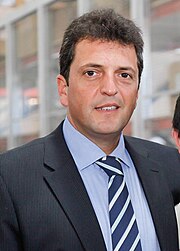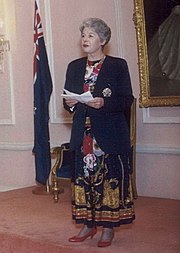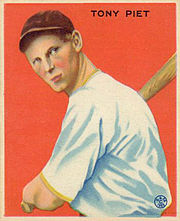Design
Design
Personality
Chart Properties
Your Cross represents the specific theme of your life. This cross embodies your unique potential & the lessons you're here to learn, providing a roadmap to fulfilling your life purpose.
We use the UTC birth time and date to do the calculations required to generate your Human Design chart.
Buy Tokens
Pay as you use, no expiry and no subscription required.Prompt Ideas
Get inspired with some epic prompt ideas.Barbara Bush's Biography
American First Lady, the wife of politician George Bush, whom she married on 6 January 1945 after meeting him at a Christmas party in 1942. They had six kids, but lost one daughter to leukemia on 11 October 1953. She and her husband had a total of 14 grandchildren and seven great-grandchildren.
Barbara Bush was raised in a five-bedroom brick house in Rye, New York, almost at the border of the golf club. They did not have a fortune but they did have a large social inheritance. Her mother was the daughter of an Ohio Supreme Court justice, and her father, a member of a once wealthy Pennsylvania iron clan, was a distant relative to President Franklin Pierce. Barbara was the third of four kids, something of a social leader and arbitrator as a youngster. If she said, “We won’t speak to Posy today,” no-one spoke to Posy, giving the girl a miserable time. Pauline Pierce was a beautiful woman, but rather humorless and austere, critical of her daughter Barbara.
For her junior year in high school, Barbara followed her sister to Ashley Hall, a genteel ladies’ prep school in Charleston, SC, the kind where a chaperone accompanied the girls to dances at the Citadel. Her early pudginess had dropped off and she was a slim and pretty teenager with pale skin and large, dark eyes. Barbara was closer to her father than her mother, and from them both learned the lessons of gender politics, a model of how mom rules the roost but dad wins the popularity contests.
The goal of a woman of that day was to gain importance through her marriage, the end all of status, stability and sensibility. Within weeks of Pearl Harbor, while home from school on Christmas break, Barbara met her destiny. It was a dance at the Club where Barbara and George, just 16 and 17, locked into each other with a striking seriousness, a mixture of teenage crush and wartime gravity. It was three years before they married, but that conclusion was never in doubt. They were in the same class and well suited.
George was a catch, string-bean handsome, a big man on the Andover campus, from a good family and a glamorous figure with his enlistment. She was wild about him and invested her whole life in him. They married in grand style while he was home on leave in 1945.
By the time they reached their late 40s, there was a marked disparity in their looks. He was spare and still youthful looking, graying but tall and striking and she was lined and bowed, snow-topped and with a middle-age spread. She tried diets and dyes for a while before deciding to go along with nature. It was George who was the initiator, starting his own company, raising money back East, always instigating a great adventure, and it was Barbara who lived a life of hard work. In the first six years of their marriage they moved at least 11 times. Over 14 years she bore six kids, George, Robin, Jeb, Neil, Marvin and Dorothy. For long periods, Barbara raised the kids while George traveled. To the kids, he played good cop and she, bad cop. She had the duty roster. She was 28 years old when she made the decision to attempt a surgery to relieve the suffering of their three-year-old; George could not be reached. He reached the hospital shortly before their baby Robin died of leukemia.
In defining herself as a wife and mother, Barbara Bush spoke for millions of women of her generation. In taking a subordinate role and holding the family together, she was observing the sexual politics of her generation. She did it as her life work, without reservations. She played the penultimate political wife, always solicitous of George and ready to accommodate whatever came up. Her house was spotless and her kids well disciplined and neat. She also ground her teeth at night and smoked by the pack.
She soldiered her way through a losing Senate race, two terms in Congress, and a painful second Senate loss. She kept her public smile in place through Bush’s stints as Richard Nixon’s ambassador to the U.N. and then as chairman of the Republican Party. They spent time in China, which she loved, and she spent endless hours in volunteer work.
First Ladies have a long tradition of selecting one cause as a pet project. Barbara Bush’s choice was fighting illiteracy. But at heart, she believed that volunteer work was something akin to personal salvation. She told U.S. News that in 1976 she suffered severe depression after she and George returned from their two-year stint in China, where he had been the chief U.S. liaison officer. They had been together virtually full time, often bicycling happily through Tiananmen Square as they went sightseeing and visiting friends all over Beijing. Then it all changed. Bush’s job as director of central intelligence suddenly absorbed all his time, the children had left home and Barbara felt miserable, sorry and lonely. So she threw herself into service work, volunteering at the Washington Home, a health-care center for the seriously ill where she performed basic tasks such as changing bedding and washing the patients’ hair. After about six months, she emerged from the trough, and the depression did not recur.
Perhaps the most painful time in her life was when their three-year-old daughter, Robin, died of leukemia in 1953. Again, volunteer work helped assuage the grief. For a while, she said, “I played with my children all the time until I heard little George saying to his friend out the window, ‘I can’t play with you today. I have to play with my mother.’ And that’s when I threw myself into the League project.
Working with the forerunner of the Junior League, she set about establishing a thrift shop in Midland, Texas to help clothe the poor, trudging through the run-down, dusty neighborhoods to stimulate interest and making the rounds of air-conditioned clubs and homes of wealthy friends to solicit contributions. She also worked at Midland Memorial Hospital as a volunteer, doing basic chores.
While her husband was Ambassador to the United Nations from 1971 to 1973, Barbara worked every Tuesday and Thursday morning at New York’s Memorial Sloan-Kettering Cancer Center where Robin had been treated two decades before, again doing the most humble of jobs. From the start of her husband’s career in Washington, including his two terms as Vice President, Barbara would privately visit the Washington Home once a week.
She came from an upper middle-class household that considered quiet, unobtrusive service to be an essential part of life. With a distaste of publicity and ostentatiousness, she would be embarrassed if she thought her works were considered to be “grandstanding.”
She dropped out of Smith College in her sophomore year to marry George and allowed him to make the family’s major decisions. A friend tells of how, after moving to California in 1949, George came home one day and announced that the family was returned to Texas. Though she dreaded packing up and making another move, she replied in typical fashion, “I’ve always wanted to live in Midland!”
Efficient and well organized, Barbara gained a great deal of popularity with the press and the public during her husband’s political life. Her joy of life and personal modesty were big reasons for her amazingly high approval rating. People felt that she was down-to-earth, someone they could trust and know as a confidant, and that she balanced George Bush. Her sense of humor may not have been neglected. When reporters asked about the double vision she had from a medication she took for Graves’ disease, a thyroid disorder, she sauntered over to the cameras, crossed her eyes and said, “They’re fine.”
Family centered, she was always protective and loyal. She refused to discuss any of her kids, other than express her support for them. Neither she nor George would tolerate self-pity in themselves or in people around them. She was a realist in her approach to life, America’s grandmother with white hair, fake pearls and real family. She baked cookies, knitted and did needlepoint.
Nonetheless, she wielded a powerful influence. People quaked in fear of her disapproval and adjectives were used by staffers such as “difficult,” “tough as nails,” “demanding,” and “autocratic.” She was known to come out with acid comments on her political opponents and was, in fact, a consummate politician. Though she herself might tend a joke about her lack of designer fashion, her waistline, her age, woe be to any speechwriter who might attempt such humor. She controled her own press, delivering useful messages such as holding an AIDS baby, but avoiding tête-à-têtes with reporters who might touch upon personal issues. Some writers called her a caustic and judgmental woman who kept her sharp tongue in check in public. Two contradictory threads ran through her history. The first was her rigorous fealty to the gender roles of her day, and the second was the clear force of her personality. She was the woman of her class and of her day, the good citizen and the good wife and mother, who still managed to teach her family that it was she who was boss.
In November 1988, her husband was elected U.S. President, taking office on 20 January 1989. Before moving into the White House, they had lived in 29 houses in 17 cities.
Rumors circulated since 1980 that Bush had had extramarital affairs but this had never been an overt issue. They had become more like buddies over the years and were dedicated to the same agenda. Certainly he loved to flirt. His sporting relationships with his male pals, his manic insistence on constant motion and the presence of company or crowds, were indeed as much of a challenge as the possibility of another woman. But the higher Bush rose in position, the more he needed Barbara as his balance and his anchor.
When George Bush lost re-election to Bill Clinton on 3 November 1992, the pressure of public life was replaced by more time for family and private pursuits. They moved to a new home in Houston in October 1993, from where she continued her work for the Barbara Bush Foundation for Family Literary, and worked on her autobiography. For the most part, the Bushes stay out of politics, though they did campaign for their two sons’ gubernatorial races, George Jr in Texas and Jeb in Florida. Both she and George had been golfers for years, and the profusion of flowers around their home bore testimony to her love of gardening.
Her autobiography, “Barbara Bush: A Memoir,” 1994, recalls a life that was wonderful in all respects, perhaps too saccharine to be real. She received a reported $2.2 million in advance for the book, which rapidly rose to the best-seller list.
Bush had surgery for a perforated ulcer on 25 November 2008 in Houston, Texas. On 4 March 2009 she underwent surgery to replace her heart’s aortic valve at The Methodist Hospital in Houston. She was released from the hospital on 13 March 2009.
Bush was hospitalized with pneumonia on New Year’s Eve 2013 and was released from hospital a few days later. Bush suffered from chronic obstructive pulmonary disease (COPD), congestive heart failure, and Graves’ disease. She died in her Houston home of complications from COPD at the age of 92 on 17 April 2018.
Link to Wikipedia biography
Barbara Bush
Your Cross represents the specific theme of your life. This cross embodies your unique potential & the lessons you're here to learn, providing a roadmap to fulfilling your life purpose.
We use the UTC birth time and date to do the calculations required to generate your Human Design chart.









